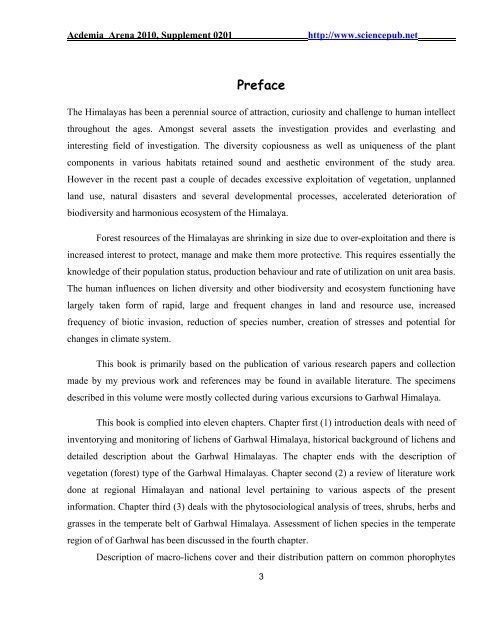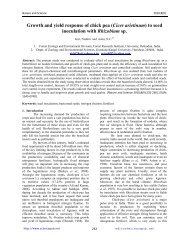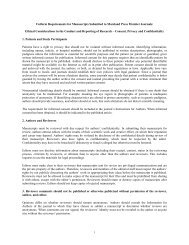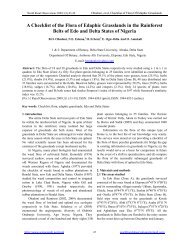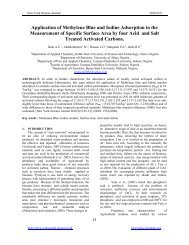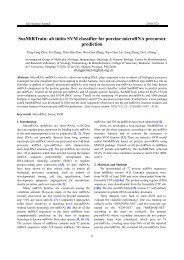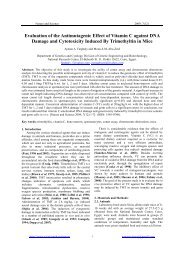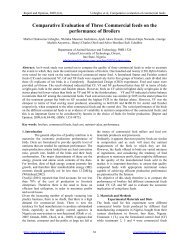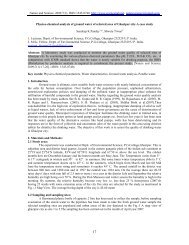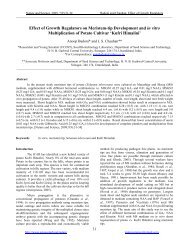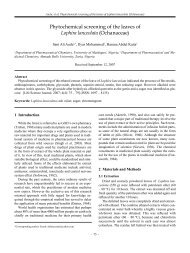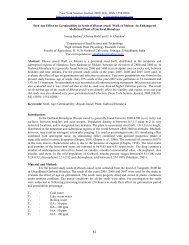Ecological, Social and Commercial Role of Lichens in India with ...
Ecological, Social and Commercial Role of Lichens in India with ...
Ecological, Social and Commercial Role of Lichens in India with ...
You also want an ePaper? Increase the reach of your titles
YUMPU automatically turns print PDFs into web optimized ePapers that Google loves.
Acdemia Arena 2010, Supplement 0201<br />
http://www.sciencepub.net<br />
Preface<br />
The Himalayas has been a perennial source <strong>of</strong> attraction, curiosity <strong>and</strong> challenge to human <strong>in</strong>tellect<br />
throughout the ages. Amongst several assets the <strong>in</strong>vestigation provides <strong>and</strong> everlast<strong>in</strong>g <strong>and</strong><br />
<strong>in</strong>terest<strong>in</strong>g field <strong>of</strong> <strong>in</strong>vestigation. The diversity copiousness as well as uniqueness <strong>of</strong> the plant<br />
components <strong>in</strong> various habitats reta<strong>in</strong>ed sound <strong>and</strong> aesthetic environment <strong>of</strong> the study area.<br />
However <strong>in</strong> the recent past a couple <strong>of</strong> decades excessive exploitation <strong>of</strong> vegetation, unplanned<br />
l<strong>and</strong> use, natural disasters <strong>and</strong> several developmental processes, accelerated deterioration <strong>of</strong><br />
biodiversity <strong>and</strong> harmonious ecosystem <strong>of</strong> the Himalaya.<br />
Forest resources <strong>of</strong> the Himalayas are shr<strong>in</strong>k<strong>in</strong>g <strong>in</strong> size due to over-exploitation <strong>and</strong> there is<br />
<strong>in</strong>creased <strong>in</strong>terest to protect, manage <strong>and</strong> make them more protective. This requires essentially the<br />
knowledge <strong>of</strong> their population status, production behaviour <strong>and</strong> rate <strong>of</strong> utilization on unit area basis.<br />
The human <strong>in</strong>fluences on lichen diversity <strong>and</strong> other biodiversity <strong>and</strong> ecosystem function<strong>in</strong>g have<br />
largely taken form <strong>of</strong> rapid, large <strong>and</strong> frequent changes <strong>in</strong> l<strong>and</strong> <strong>and</strong> resource use, <strong>in</strong>creased<br />
frequency <strong>of</strong> biotic <strong>in</strong>vasion, reduction <strong>of</strong> species number, creation <strong>of</strong> stresses <strong>and</strong> potential for<br />
changes <strong>in</strong> climate system.<br />
This book is primarily based on the publication <strong>of</strong> various research papers <strong>and</strong> collection<br />
made by my previous work <strong>and</strong> references may be found <strong>in</strong> available literature. The specimens<br />
described <strong>in</strong> this volume were mostly collected dur<strong>in</strong>g various excursions to Garhwal Himalaya.<br />
This book is complied <strong>in</strong>to eleven chapters. Chapter first (1) <strong>in</strong>troduction deals <strong>with</strong> need <strong>of</strong><br />
<strong>in</strong>ventory<strong>in</strong>g <strong>and</strong> monitor<strong>in</strong>g <strong>of</strong> lichens <strong>of</strong> Garhwal Himalaya, historical background <strong>of</strong> lichens <strong>and</strong><br />
detailed description about the Garhwal Himalayas. The chapter ends <strong>with</strong> the description <strong>of</strong><br />
vegetation (forest) type <strong>of</strong> the Garhwal Himalayas. Chapter second (2) a review <strong>of</strong> literature work<br />
done at regional Himalayan <strong>and</strong> national level perta<strong>in</strong><strong>in</strong>g to various aspects <strong>of</strong> the present<br />
<strong>in</strong>formation. Chapter third (3) deals <strong>with</strong> the phytosociological analysis <strong>of</strong> trees, shrubs, herbs <strong>and</strong><br />
grasses <strong>in</strong> the temperate belt <strong>of</strong> Garhwal Himalaya. Assessment <strong>of</strong> lichen species <strong>in</strong> the temperate<br />
region <strong>of</strong> <strong>of</strong> Garhwal has been discussed <strong>in</strong> the fourth chapter.<br />
Description <strong>of</strong> macro-lichens cover <strong>and</strong> their distribution pattern on common phorophytes<br />
3


